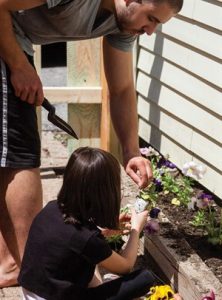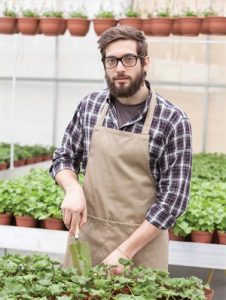Sally Benson — May 13, 2015
Kelly Norris has a lot of energy. True, it could be his youth, but it’s really the kind of contagious energy that’s driven by passion. If you’ve had the opportunity to hear him speak at industry conferences, if you’ve read his books, if you’ve met him, you can’t help but be energized by his enthusiasm.
Ask Norris a question, and prepare for an earful – in a good way. It’s obvious within the first few seconds of a conversation that he’s determined to do what he can to make this industry thrive. He’s in a unique position to offer the younger generation’s point of view, with a twist. He’s been there; he’s done that. He’s in touch with the Millennials, but he also has a wealth of knowledge, insight and experience that belie his years. He’s been called a “rising star of horticulture,” and that very well may be so. But this star is on a fast track.
At the age of 15, he convinced his family to purchase the stock of an iris grower in Texas and start their own iris farm in Bedford, Iowa. At 24, he received his master’s degree in horticulture from Iowa State University; in 2012, at the age of 25, he published his book, A Guide to Bearded Irises. That same year he accepted the position of horticulture manager for the newly renovated Greater Des Moines Botanical Garden. He speaks to crowded rooms at industry and public events, where he shares his passion – and his knowledge – with curious growers and eager gardeners.
We recently asked Norris to share his perspective on the industry and, more specifically, how the industry can capture – and cultivate – the younger generation of gardeners. Norris calls it the “million dollar question.”

Photo: iStock|bogay22
“I think one of the reasons we’re not connecting with people is because we don’t understand why we’re in business,” he states. “I think the purpose of what we do is unclear, and I think it’s because the links in our chain are shorter and shorter. The liner producer sees his end user as the rewholesaler and the finisher who buys his liners, instead of realizing that somewhere along the way, that liner is going to grow up to be a tree that a Latino worker is planting on a commercial job site somewhere, or that my sister-in-law is planting in her back yard.
“We need to understand vertically how our business works,” he continues. “But we spend so much time focusing on the interface at retail that we tend to forget that when there’s pain at retail, it’s going to shake all the way up through the supply chain, and that’s what’s happening. And so the producers are asking, what do I do about it?”
Norris has a few answers, and he begins with food.
Inspiration from the food movement
That’s right: Food. But we’re not just talking about incorporating edibles into the production program, or offering herbs and vegetables at retail.
“We’ve got to think through the supply chain,” Norris explains, “and the analogy that I give is about the food movement. There’s a really incredible template for how the industry could see its future in what’s happened in the last 60 years in this country as it relates to food. You have these luminary, culinary figures, like James Beard and Julia Child, who created a new conversation around food at the American table 60 years ago. They did so by challenging the notion of what inspired the American meal.
“The next phase of that movement, in some ways, was thinking about where the ingredients came from,” he adds. “It was very much about the provenance of food; it was about the provenance of ingredients, and it led to this flourishing local farms and local producers movement that we’re still very much in the middle of.
“And at some point in the last 10 to 15 years we’ve entered a third chapter of the food movement, which I think is really striking out and defining what is the American original cuisine,” Norris continues. “What does this new American food movement actually mean? What does it mean to create an American meal that isn’t just a composite of its immigrant culture?
“In some ways, if you look at those three levels – the inspiration, the ingredients and the fusion of an original movement – that parallel to horticulture is very strong. We have bits and pieces of each of those chapters in parallel, just not as well organized or as well tuned in to a narrative that the food movement has had in the last 50 or 60 years, and particularly in the last decade.”
It’s certainly food for thought.
Celebrity chefs have made food intriguing to younger consumers, who are inspired to be adventurous with meal planning and consumption. Lore – a little bit of background, some interesting trivia – makes the ingredients that much more interesting. Further, there’s a purpose to their pursuit. And that’s what Millennials want: a purpose.
What’s the purpose?
“It’s something we all need to think about, whether we’re producers, landscape professionals, public horticulturists, or we’re in retail: What is the purpose of horticulture?” Norris poses. “What is the value of having horticulture in our lives? We know that a life, a city, a living space without horticulture is a blank, destitute, depauperate kind of existence. We know that green space is critical to our quality of life, yet, we don’t do a very great job of selling that.
“The intrinsic values are naturally the hardest to sell,” he continues. “And I think we trivialize the extrinsic values, too. We try to base the conversation on things that, ultimately, maybe don’t matter to people. It’s not just how long it blooms; maybe it’s deeper than that. So we’ve got work to do: Thinking through the supply chain, from producers to consumers, and really thinking about what relationship and experience we want our end users to have when they come in contact with our services, our products and, ultimately, the total nature of the experience we offer people.”
Is this the way to attract that next generation? Norris thinks so.
“It’s a new way of thinking about gardening,” he claims. “It’s a more holistic, more integrated approach to gardening that I think gets to that Three-P notion: Horticulture is about People, Plants and Passion. It’s an act of humanity. People, plants and passion equate to this idea of gardening with some sense of purpose. People are already doing it, and I think that if the industry could get one step ahead of it and actually think about how to strategically go after this in an economic sense, I think there’s some real powerful momentum that we could have.
“So first and foremost we have to understand that horticulture is an act of humanity,” Norris says. “We have to understand that it’s a choice that people are making about how to spend a certain amount of time in their life. But it’s an act of humanity that’s born from a passionate interaction with plants. There’s an economic scale to that, too. People who don’t have much motivation to garden don’t spend a lot of money on gardening. People who are highly motivated to garden spend a lot of money on gardening.”
an act of humanity that’s born from a passionate interaction with plants. There’s an economic scale to that, too. People who don’t have much motivation to garden don’t spend a lot of money on gardening. People who are highly motivated to garden spend a lot of money on gardening.”
Gardening with a purpose is a powerful motivator, and perhaps that means concentrating our efforts on those who are, well, ripe for motivation.
“Our industry has so often focused on the lowest end of the spectrum; we’re driving after the lowest common denominator, because we think that’s the majority … and it is the majority,” Norris explains. “But going back to what I said about the food movement, the food movement didn’t evolve because it was driving after getting the majority of people to do French-style cooking in their home kitchens; it was trying to drive the average higher. Trying to look at that tribal sense of devotion and dedication and passion that comes when people really get plugged into an avocation or a lifestyle.
“And so that’s the track record we have to move on. We have to drive people to a place of purpose, where gardening becomes not just raising your own food, it doesn’t become just beautifying your lawn, it doesn’t become cleaning the air in your house with houseplants, or all these other little things that we seem to spend so much of our time marketing with. It becomes all of this; it becomes the idea that gardening is a right and purposeful and sort of quintessential thing for an American household to do.”
New perennial movement
Just as the food movement helped to create a passionate population of food enthusiasts, Norris says the new perennial movement can do the same for horticulture. And it ties in with the search for purpose.
“For the production side of things, I think the big thing is to take a look at the inventory and study the numbers,” he says. “Let’s talk about more diversity in the landscape and in the marketplace. We’re going to trend that way. The new perennial movement, if it has any impact long term on the way people think about design and construction in building landscapes, it’s going to be about adding diversity in the landscape. It’s why we’re talking obsessively about planting for pollinators and really gardening with a greater sense of purpose. Not just for aesthetic enjoyment, but for the functions of the landscape.
Photo: iStock|sematadesign
“It means there’s going to be a whole new craving on the part of consumers, saying, hey, we want to grow bladder nut in our back yard because those little flowers are great nectar sources for early butterflies. I think those questions are going to become more common. It may not be this year, it may not be next year, but it will be in five years, and it certainly will be in 10 years. There’s going to be more demand for that, and so the production chain is going to have to consider how to get outside of the boxwood, red maple, barberry block and figure out how to become a real green industry and actually start righting the course and actually being a partner in developing these new markets.”
The market is there; we just have to tap into it
We read the doom-and-gloom reports about the changing garden market – Baby Boomers, who are most likely to spend on gardening, are slowing down, and the younger generation isn’t interested, either in gardening or in the business of horticulture. Not so, says Norris. The recession took a toll on the industry, to be sure, but those businesses that were flexible managed to survive. And many have found there’s a new market to address.
“The market has really changed, but I don’t think the market is smaller; I don’t think that’s true at all,” Norris says. “Even if you just assume the percentage of the population that gardens – some estimate it’s as high as 30 percent, but they count people who buy weed-and-feed in that category – nothing about that percentage changes. Our population is growing; there are 15 million more Gen Ys than there were Baby Boomers. In 10 years, there will still be more consumers in our marketplace.
“The market is not shrinking,” Norris continues. “I think in many ways the marketplace itself doesn’t understand how to adapt to a growing market. It’s creating opportunities; I think there’s going to be a lot of opportunities for young entrepreneurs to enter into the new business concepts. It’s happening. And fortunately, they have access to some loan monies to make some of that happen. The same kind of struggles are still there, and bankers still look very shrewdly at people trying to get into the nursery and the production industry; it’s an industry that historically has low margins, high operating costs. You know, those questions aren’t going away. … I know this well, because I grew up in a farm family, who also ran a nursery and ran a construction business through the downturn. I get it; I know what it’s like to have sobering conversations about cash flow; I know what it’s like to have a sobering conversation with your lender, saying, I can’t do this, something’s got to change here, I can’t make this payment; I need different terms. I get that; I’ve been there, I’ve done it.
“And so I understand that the conservativeness of that business model, and the nature of slim margins can motivate people to be very, very cautious about how they approach new ideas. But someone, somewhere has to take a risk.
“I am the ultimate optimist: I’m not worried or stressed by the recalcitrant business models, because the fact of the matter is we live in a world where creative destructionism is probably at an all time high. The world has chosen a new course of how it communicates, for how it does business. The very nature of our society has changed drastically in the last decade, just in terms of how we communicate and what we communicate about. It’s really going to challenge the business structures that are more rigid and less dynamic and flexible; it’s really going to challenge their sustainability.
“I think there’s a niche right now for young people to try new business concepts and business models because banks are anxious to try and get some money out there into the market to invest. I think there’s opportunity here; I think there’s opportunity ahead.”
Cover Photo courtesy of Kelly D. Norris